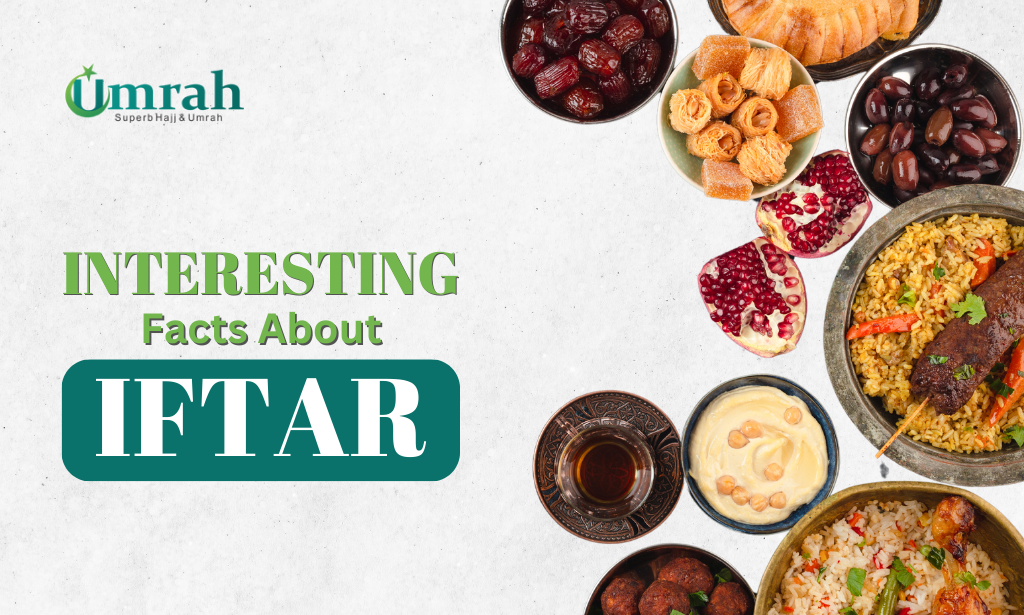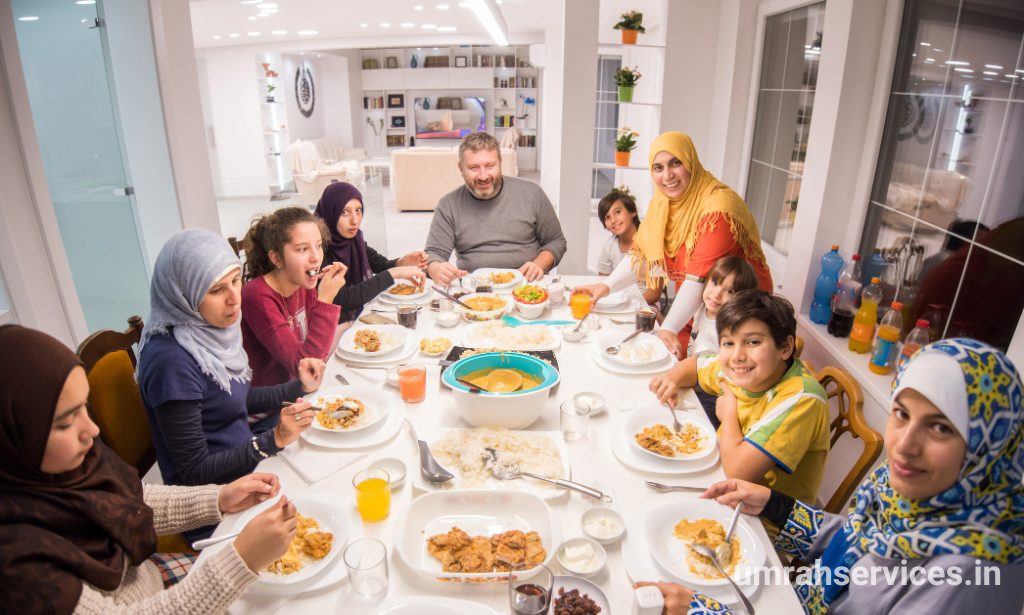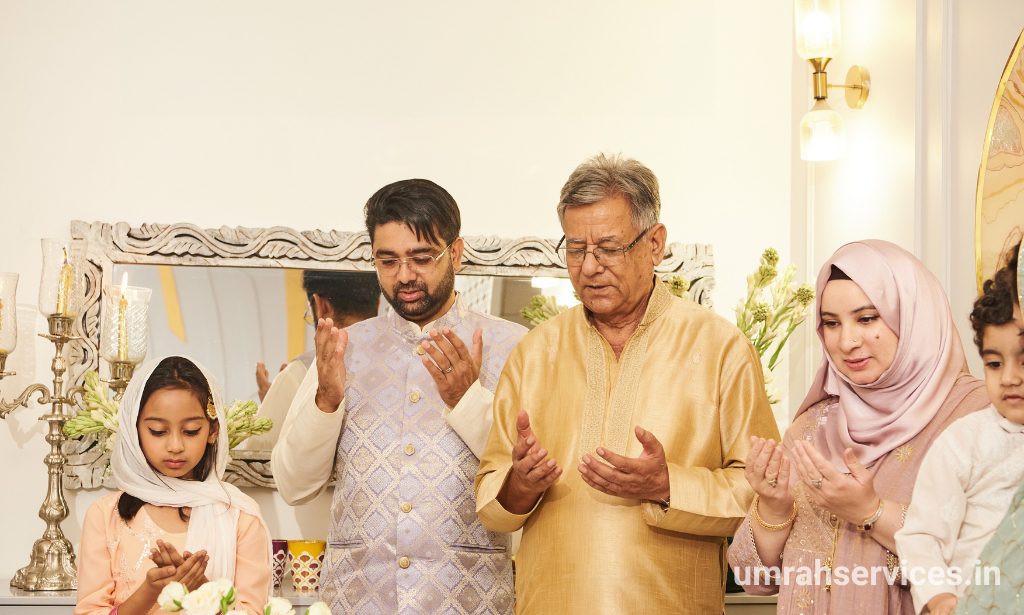
Iftar is a moment of relief, reflection and bonding for the Muslims globally during the sacred month of Ramadan. Millions of Muslims worldwide break their fast every evening to mark the end of a day’s spiritual journey and self-restraint. But Iftar is more than a meal, it is an important pillar of faith, culture, and community.
This ritual with its trace back to the Prophet Muhammad (peace be upon him), gathers loved ones together, fills hearts with gratitude, and amplifies empathy towards people in need. From the dates and water that begin the meal to the diverse dishes enjoyed worldwide, Iftar perfectly reflects unity and cultural diversity within the Islamic world.
In this blog, we will look into the various interesting facts about Iftar. Without any further ado, let’s dig into the what is Iftar, history, traditions and everything you need to know about Iftar.
Also Read:- Riazul Jannah – A Garden of Paradise
What is Iftar?

Iftar is the meal with which Muslims end their day-long fasting during Ramadan. For millions of Muslims who fast during the holy month of Ramadan, Iftar is more than just a meal; it is a spiritually significant act of bonding families and communities together.
It brings together people from different walks of life. This cherished tradition merges faith, culture, and shared moments while strengthening bonds between families, friends, and communities.
From sweet dates to warm, rich soups and loads of cultural delicacies, Iftar reflects the diversity within the Islamic world.
What is the History Behind Iftar?
The history of Iftar traces back to the earliest days of Islam. The history of iftar is closely tied to the origins of Islam and its established customs and traditions established by Prophet Muhammad (PBUH).
‘Ramadan’ and ‘fasting’ are mentioned and well-established duties in the Quran, where directions are given to Muslims to fast from dawn till dusk and not eat, drink, or participate in any activities that are not considered holy.
Fasting during the month of Ramadan is a symbol of devotion and self-discipline, reminding Muslims how they should purify themselves and strengthen their relationship with the almighty Allah.
Prophet Muhammad (PBUH) further stressed that the fast must be broken immediately after sunset.
“The people will remain upon goodness as long as they hasten to break their fast”
(Sahih al-Bukhari).
Following in his footsteps, this is how Muslims traditionally break their fast with dates and water before offering Maghrib prayers or Salah and indulging in a fulfilling meal. Dates were practical at the time, because dates are very nutrient-rich, helping restore one’s energy after a long day of fasting.
In due course, as Islam flourished around the world, the simplicity of dates was mingled with cultural foods and customs making iftar a different experience everywhere in the world. But the heart of Iftar remains the same: gratitude, humility, and community, across the generations.
Also Read:- How to Prepare for Umrah
What Time is Iftar?
Iftar occurs at sunset every day in the month of Ramadan. This coincides with the time of Maghrib. The exact time of Maghrib varies according to geographical location and it changes every day slightly.
Each town has its own Ramadan calendar or app that one can check to know the time of the prayer and iftar set for each day. Many cultures wait for the Adhan to be called from mosques in their vicinity to mark the end of fasting.
The exact time of iftar may differentiate slightly from one city to another but the importance of that moment remains the same everywhere, serving as a reminder of the unity of the global Muslim community breaking their fast together.
Also Read:- Five Pillars of Islam
What to Eat for Iftar?

Traditionally, Iftar begins with dates and water, as practised by the Prophet Muhammad (peace be upon him), who is reported to have broken his fast with dates and water or milk. Dates are symbolically significant and nutritionally beneficial, providing a quick source of natural sugars, fibre, and essential nutrients after a long day of fasting.
In the present day, however, Islam has reached almost every corner of the world and people have incorporated their own touch in what they eat for iftar. Every region has its speciality that best suits its nutritional needs.
Also Read:- A Guide to Ziyarat in Mecca & Medina
Some of the popular iftar dishes are:
- Fruits and Nuts – Many include fruits such as bananas, apples, and oranges in their iftar meals as these provide them with an instant boost from natural sugars and fibre.
- Soups – Lentil or chickpea soup forms the most important part of hot dishes after the fast is broken. These are nutritious, warm dishes that will not strain the stomach. It is very commonly consumed as an integral part of iftar meals worldwide.
- Samosas and Spring Rolls – A little indulgence after a day of no food or drink is in order. Fried snacks, mainly consisting of samosas filled with either meat or vegetables, are another popular dish in South Asia and the Middle East.
- Salads – Fresh salads offer hydration and fibre and make digestion easy. Fattoush or simple green salads are common. Salads are a common sight during iftar as they help balance the meal.
- Sweets – The Middle Eastern Iftar is often ended by conventional sweets like kunafa, qatayef, or basbousa while in South Asia sheer khurma sweetly finishes the meal. Each region has its specialities.
- Main Course – The main course differs from region to region. Many of the regions have rice and meat dishes, which include biryani, kabsa, or makloubeh. In a few regions, pasta or noodle-based dishes feature as part of the main course.
Also Read:- Nabeez Drink Health Benefits
What to Wear to Iftar?

Iftar gatherings range from the most casual in the form of family meals to the most formalized event, especially in communities that hold large Iftar gatherings. The traditional dressing for Iftar is modest dressing strictly adhering to cultural and religious values, of course.
For family Iftars, comfortable and modest clothing is usually typical. However, many people wear traditional attire like thobes, abayas, or other cultural garments expressing identity and respect for the occasion for communal or public Iftar events.
In countries like Indonesia, men wear a sarong, while the ladies wear their traditional kebaya.
The Middle East has the jalabiyas or abayas and South Asians would go in with their traditional shalwar kameez. Overall, comfort and modesty are the key elements of Iftar’s attire. People generally participate in as much local flair as possible during these observances.
Also Read:- Ziyarat Places in Madinah
What Do People Traditionally Do for Iftar Globally?

As previously mentioned, iftar is a common meal that every fasting Muslim across the world consumes to break their fast, however, each region across the world has their own way of approaching the iftar meal. Let’s take a look at what different cultures traditionally do for iftar;
- Middle East – Hummus, falafel, and rice with lamb or chicken are common iftar meals. People break their fast at communal Iftars held at mosques. In Egypt, Ramadan fanous (lanterns) decorate houses and streets creating a festive atmosphere.
- South Asia – Samosas, pakoras, and Rooh Afza again appear regularly in iftar meals. Unused meals are often handed out to neighbours, and many mosques arrange public Iftars, which could also improve social cohesion.
- Turkey – Iftar starts with dates, olives and soup. Most Turkish cities now have iftar tents, where people assemble for dinner, and Ramadan drummers call people out for Suhoor, continuing an Ottoman tradition.
- Indonesia and Malaysia – Rice-based dishes such as nasi lemek and sweets like kolak are good examples of iftar dishes in the region. Evening congregations in mosques are a common occurrence and bukber is a popular tradition to break the fast together.
- Africa – Harira soup and briouats are a common part of the iftar meal, while East Africa enjoys sambusas and plantains. During Iftar gatherings, the family’s oldest member usually leads the congregation’s prayers.
- United States and Europe – Generally, in the West, Muslims tend to mix traditional food with locally produced food. The Iftars are often potluck-style with open gatherings at mosques to promote socialisation and conciliation.
The customs of each region translate the ultimate diversity and unity found in Islam, and they celebrate elements of charity, hospitality, and coming together for each other.
Also Read:- Five Pillars of Islam
Interesting Facts About Iftar
- Breaking of the Fast with Dates – According to the Sunnah of Prophet Muhammad (peace be upon him), Muslims everywhere in the world break their fasts by dates. Dates contain many nutrients and can easily restore the body, one that has been starved both of water and food, thus it makes an ideal ‘pick me up’ for those fasting.
- Community Iftars in Mosques – Mosques in most countries hold common community Iftars for people of all walks of life to gather and feast as one. It represents unity in expression and practised hospitality between individuals.
- The Ramadan Cannon – In cities like Cairo, Dubai, and Amman, at sunset, a cannon is fired marking the end of fasting for the day. It is a practice that dates back to the old days when people used this as a means to sound the Iftar time.
- Open-air Iftar – Turkish organisations and people use Sultanahmet Square in Istanbul for massive open-air Iftar events. Thousands of people are accommodated in the area during this event. Residents and tourists alike like looking forward to Ramadan for this event.
- Iftar with non-Muslims – Muslims in most places invite their non-Muslim friends and colleagues to share food and conversations.
- Global Timings – Since sunset is location-dependent and differs according to geographies, Muslims break their fast at variable times across the world. Interestingly, in polar regions, they tend to follow the Iftar timing of the nearest city that has a normal day-night cycle since some parts of this region sometimes experience continued daylight.
Also Read:- History of the Kaaba
Conclusion
Iftar is more than just a meal; it is a celebration of faith, gratitude, and community. It is the simple act through which people globally unite to break their fasts. Muslims witness and take part in this tradition by breaking borders, language and cultural barriers.
Iftar signifies the essence of Ramadan: empathy, devotion and unity. Whether at home or with friends in a community setup, Iftar is a cherished experience that brings people closer, enriching the spiritual journey of Ramadan.
Frequently Asked Questions
Q. What is an iftar meal?
A. Iftar is an evening meal that Muslims worldwide consume to break their fast. It typically consists of dates, water, soups, fruits and other traditional dishes.
Q. What do Muslims do for Iftar?
A. Iftar is that time of the day when families and communities come together to break their fast. Muslims eat, pray and strengthen community bonds a the time of Iftar.
Q. What is the reason for iftar?
A. Iftar is observed to break the daily fast during Ramadan at sunset, as prescribed in Islamic teachings. It symbolizes gratitude to God, fosters self-discipline, and serves as a moment of reflection and community bonding, reminding Muslims of the importance of empathy and charity.
Q. What is Iftar and Suhoor?
- Iftar and Suhoor are two key meals during Ramadan, observed by Muslims worldwide as part of fasting.
- Iftar – It is the evening meal consumed to break the fast at sunset, traditionally started with dates and water, followed by a full meal.
- Suhoor – This is the pre-dawn meal consumed before the fast begins at Fajr (dawn). It is an important meal that provides the energy and sustenance needed for the day’s fast.
Q. What is iftar food?
A. Iftar food is the sunset meal to break the Ramadan fast, starting with dates and water, followed by a nourishing spread of fruits, savoury snacks, and main dishes, fostering energy, gratitude, and community togetherness.
Q. What is an Iftar party?
A. An Iftar party is a gathering that occurs during Ramadan where guests come together to break their fast at sunset. In the iftar party, guests share traditional Iftar food and promote community spirit.
